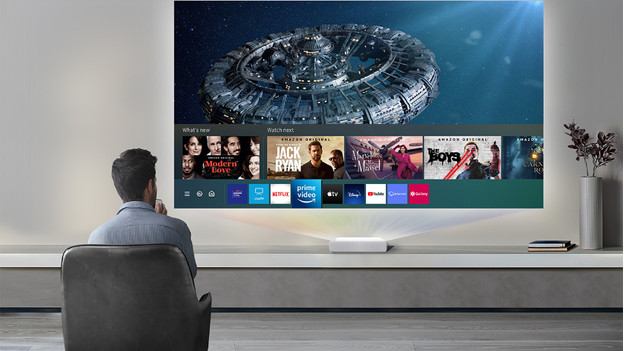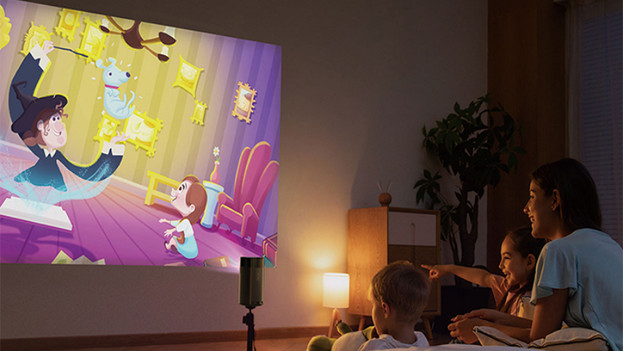
How do you choose the right resolution for a projector?
Choose the resolution
You may have heard from Full HD or 4K resolution. But projectors have many more resolutions, like (Super) VGA, (Wide) XGA, and Wide UXGA. Which resolution you choose mostly depends on your usage situation. Here you can find which resolution is suitable for your usage situation.
- Home cinema: Full HD or 4K
- Business use: Full HD, Wide UXGA, or 4K
- Education: Full HD, Wide UXGA, or 4K
- Large rooms: Full HD, Wide UXGA, 4K
- Basic use: (Wide) XGA, HD ready, Super VGA, and Wide VGA
What does resolution mean?
First, what is resolution exactly? Let's say you're looking at a picture that is projected on a screen by a projector. The picture seems to be a coherent image. But in reality, the image is made up out of very small color points, also called pixels, that together form a whole. So the more pixels, the more detailed the image. The resolution is expressed in the number of vertical and horizontal pixels. For example, a Full HD resolution has 1920 horizontally and 1080 vertically, which we write out as Full HD (1920x1080).
Determine the aspect ratio
For choosing the right resolution, you want to look both at the amount of pixels and the ratio of the number of horizontal versus vertical pixels. We call this aspect ratio, and indicate this with the lowest number possible. For example, if you divide both numbers by 120 in the case of a Full HD resolution (1920x1080), you get a 16 to 9 ratio. In addition to 16:9, you can also find the aspect ratios 4:3 and 16:10. To get a good projection, without black bars on the sides, the aspect ratio of the projector has to be the same as the image source.
Home cinema: Full HD or 4K

Almost all movies and series are made in wide screen, which has the same ratio as 16:9. That's why we recommend you to choose a projector with this aspect ratio. In addition, we also recommend a Full HD or 4K resolution. Because you don't want to miss out any details as a movie lover. Even if it's about the Olive in the Martini of James Bond, or about the head of the spider in a nature documentary, these detailed contribute to the movie experience.
Business use: Full HD or higher

Even though 4:3 and 16:10 used to be common aspect ratios for the display and computer industry, it has shifted to 16:9. Why? Simply because (tech) companies argued that because your eyes are next to each other, the screen should be more horizontal too. It's useful if your colleagues can still read the letters and numbers of your presentation while they sit all the way in the back of the meeting room. That's why we recommend a Full HD or 4K projector. Do you still have a 16:10 aspect ratio? You might consider a Wide UXGA resolution.
Education: Full HD or higher

For education, the same rules apply for resolution as with business use. You choose the same aspect ratio as the image source. This is often 16:9, and sometimes 16:10. In addition, you want the students in the back of the classroom to see just as many details as the students at the front. That's why we recommend a Full HD, Wide UXGA, or 4K resolution.
Large rooms: Full HD or higher

Maybe you've tried to enlarge a photo on a computer. If the photo has bad quality, it gets more blurry the more you zoom in. This also happens with the projection of your projector, which is also enlarged in a conference room or classroom. That's why we recommend at least a Full HD or Wide UXGA resolution. Choose 4K if you care about details. Keep the aspect ratio of the image source in mind. Chances are it's 16:9 and so you'll choose a Full HD or 4K resolution. In some cases, the aspect ratio is 16:10. If so, choose a Wide UXGA resolution.
Basic use: all other resolutions

But how about all the other resolutions? We recommend those if you use the projector for a movie every now and then, but don't care much about a good image quality. The images of these resolutions are less sharp, so details aren't as clearly visible. This doesn't matter when you occasionally use the projector, but it's disappointing if your colleagues can't read the information on your presentation properly, for example. From all the lower resolutions, Wide VGA, qHD, and HD ready are part of the common 16:9 aspect ratio.


